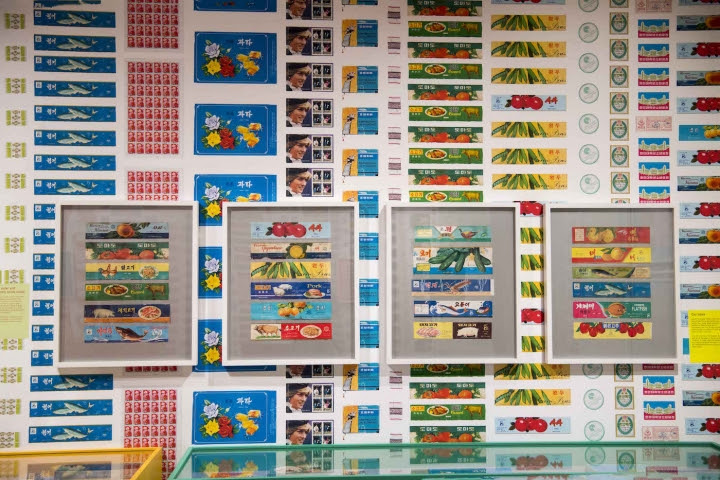Much of the art that leaves North Korea travels to a small village outside Tuscany, where Pier Luigi Cecioni runs his gallery.

Installation view of House of Illustration’s Made in North Korea: Everyday Graphics from the DPRK, featuring North Korea including posters, sweet wrappers and stamps from the collection of Nicholas Bonner (image courtesy House of Illustration, photo by Paul Grover)
It only takes five days for art to travel from North Korea to Europe. Surprisingly, DHL has serviced the Democratic People’s Republic of Korea since the late 1990s when it established an experimental delivery service in the country. (Being a German company, DHL is not beholden to America’s strict economic sanctions on business with Pyongyang.) Much of the art that leaves North Korea actually travels to a small village outside Tuscany where Pier Luigi Cecioni runs his modest gallery devoted to the art of Mansudae Studio, one of the world’s largest art production centers operating since 1959.
Mansudae is a major moneymaker for the DPRK government, but a recent article published by CNN speculates that their cash flow is starting to run dry despite a surge in interest for North Korean art. As the New York Times reported in 2016, the studio has increasingly contracted its workers out to cultural institutions in Africa, the Middle East, Southeast Asia, and even Germany. Known for producing monumental sculptures (its artists are rumored to be the only ones allowed to portray members of the Kim dynasty) Mansudae has also created Frankfurt’s Fairty Tale Fountain and a large-scale cyclorama in Cambodia’s Angkor Panorama Museum.
The profits Mansudae has raked in from these artistic projects directly feeds into North Korea’s coffers, according to the United Nations. Sanctions ratified by the international organization’s Security Council in 2017 froze the assets of Mansudae’s overseas construction company alongside two DPRK banks and an insurance company.
Cecioni has clarified that he does not sell North Korean art on consignment, instead reselling whatever he directly buys from Mansudae. Further, he claims that the studio’s statue business is separate from the art studio despite operating under the same name. “The money they received from us essentially goes back into running the studio,” he told CNN earlier in May.
The studio has an estimated 4,000 employees, 1,000 of which are artists, and 1.2 million square feet of space. Mansudae works in a variety of mediums: woodcuts, oil paintings, charcoal drawings, embroideries, and even jeweled paintings made with semi-precious stones. According to Cecioni, these works can range anywhere from $300 to $7,000 dollars in price. The most popular (and cheapest) items are hand-painted propaganda posters.
Like Soviet social realism and Chinese Communist propaganda posters, North Korean art rarely conceals its political message. Soldiers and farmers are common subjects in Mansudae’s figurative painting. Landscapes and flower studies are two other popular genres, pulling on more classical techniques of ink paintings on paper. And despite the growing threat of nuclear disaster, the studio typically has a cheery outlook on life, positioning the DPRK way as more utopian than reality. (Annual GDP is ranked 197th in the world, according to the CIA World Factbook.)
Speaking with CNN, Cecioni recalled beginning his relationship with Mansudae during an official tour of North Korea with the Italian orchestra back in 2005. He asked his handlers to see examples of North Korean art. When he came to the studio, he simply asked if they would be interested in doing some business in the West. Sure, they answered.
But the UN sanctions have limited what Cecioni can import from North Korea. Thankfully he still has over 300 pieces in storage, but international demand for artworks hasn’t slowed. Naturally, Cecioni has begun rejecting sales of his works as he reevaluates their prices given their new state as rare examples of North Korean art.
Given the surge in Western interest about North Korea as peace talks potentially commence, Cecioni’s gamble is likely to pay off. Even common objects from the country are drawing crowds. Most recently, London’s House of Illustration produced an exhibition and accompanying catalogue displaying the collection of Nicholas Bonner, an expert in North Korean graphic culture, tourism, and film. If onlookers are lining up to see canned food from North Korea, then what size crowds will fine art bring?

Installation view of House of Illustration’s Made in North Korea: Everyday Graphics from the DPRK (image courtesy House of Illustration, photo by Paul Grover
)

